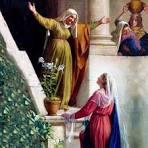
We actually know relatively little about Mary, mother of Jesus. Most of our information comes from Luke, who narrates a fairly full account of the conception, birth and early childhood of Jesus (Luke 1:26-57, and Luke chapter 2). Mark only mentions Mary in passing (Mark 3:31-35). Matthew gives a brief account of the conception and birth of Jesus from Joseph’s viewpoint, the coming of the Magi and the flight into Egypt (Matt. 1:18-25 and chapter 2). John has two stories: the marriage feast in Cana (John 2:1-13) and the crucifixion of Jesus (John 1:25-28).
Artists have portrayed Mary through the ages from the richness of their imaginations. However, if we want to see the real Mary, we might look no further than the mothers of Israel, Palestine or Syria. However in spite of the sparseness of the gospel accounts, we can build a picture of a Jewish woman, who was faithful to the practices of her religion yet was courageously prepared to risk being an unmarried mother in obedience to God.
It would also seem that Mary was sensitive to the needs of others. To travel to the hill country of Judea, where Elizabeth and Zechariah lived, would entail a journey of about the distance from Galway to Castlebar. Mary would almost certainly have travelled on foot, on dusty, dangerous roads. It might have taken her a week to get to her destination. Again at the marriage feast in Cana, Mary was quick to notice that the wine was running out and she was concerned for the young couple. The Magnificat canticle which Luke places on the lips of Mary is revolutionary, in that she sees God upsetting the status quo and raising up the meek and powerless.
Mary’s sinlessness enabled her to envelop Jesus in a love which stretched from the manger in Bethlehem to the cross of Calvary.
I syng of a mayden
That is makeles;
Kyng of all Kynges
To her Son she ches.
Moder and maydyn
Was never non but sche;
Wel may swych a lady
Godes moder be.
(From a fifteenth-century carol)